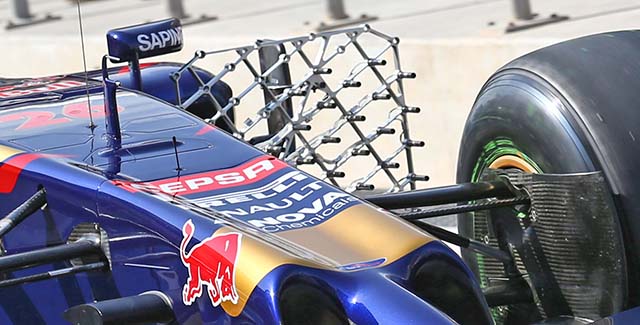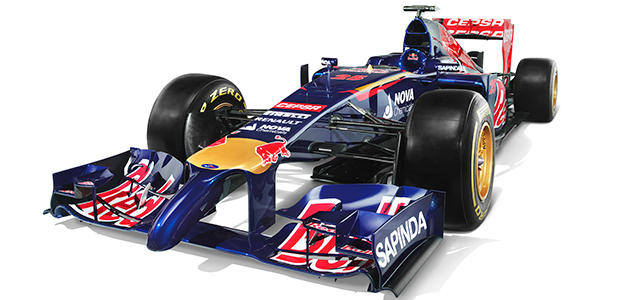

Chassis:Toro Rosso Class: F1 2014 Engine: Renault RS34 Energy F1 1.6L Turbo V6 Fuel: Petrol Transmission:8 speed sequential (Red Bull) Brakes: Brembo Carbon/Carbon 0 Weight: 690kg Fuel Tank: ATL Year introduced: 2014
Toro Rosso launched its 2014 car at the Jerez circuit ahead of pre season testing. It is the first STR design developed under the stewardship of Englishman James Key who joined the team in 2012. As the 2013 STR*’s design was already well underway when he arrived in Faenza, he focussed on the major challenges for 2014, starting with the aerodynamic aspect of the project.
“The aero side was by far our biggest priority, as we wanted to put that department into a much more current and competitive shape,” says Key. “Over the past twelve months, we’ve been working on increasing the size of the aerodynamics department. It’s grown significantly, and we now have many new people with very relevant F1 experience. We have more people joining us this year too, so I would describe it as a work in progress, but the group is developing very well and becoming increasingly close to the blueprint that we have in mind of what an aero department of a team of this size and budget needs to be. We’re still getting there but it’s certainly heading in the right direction. It’s been a big project, helped by the arrival of a new head of Aerodynamics in Bicester, Brendan Gilhome last June, while we worked on 2014 without neglecting the task of making the most of the 2013 car as well. It’s still going on but it’s developing very much in the direction it needs to be right now and we’re making good progress.”
The switch to a 1.6 litre turbo engine for next year has been the biggest talking point when it comes to this year’s major rule change and at Scuderia Toro Rosso, this has also involved a change of partner, with Renault supplying what is now referred to as the power unit (PU), primarily due to the significant mix of IC engine and Energy Recovery Systems. “Changing your engine partner is always a bit of a step into the unknown for both parties, until that working relationship is established and everyone understands how best to operate together,” reckons Key.
One of the most commonly held myths in the F1 paddock is that Scuderia Toro Rosso is just a satellite team to Infiniti Red Bull Racing, an incorrect assumption that dates back to the first couple of years of the team’s existence, when the rules were different. Today, with the exception of very few components, such as the gearbox internals and the engine, the cars are entirely designed and manufactured in-house. This year’s switch to Renault power, as used by Infiniti Red Bull Racing, means that once again, the two teams can enjoy some technical synergies. “It makes sense, given that fundamentally we are under the same ownership, to have the same power unit as Red Bull, particularly with the arrival of such a complicated new set of regulations,” continues Key. “Immediately, there’s a synergy there because we are using the same power unit, we’ve been able to join with Red Bull Technology in using their gearbox internals. They have a well-engineered solution to 2014 regulations for these components, so again, it makes sense for us to join with them in using those common internals while running the same power train. Otherwise, obviously, the rest of the car is entirely an STR design.”
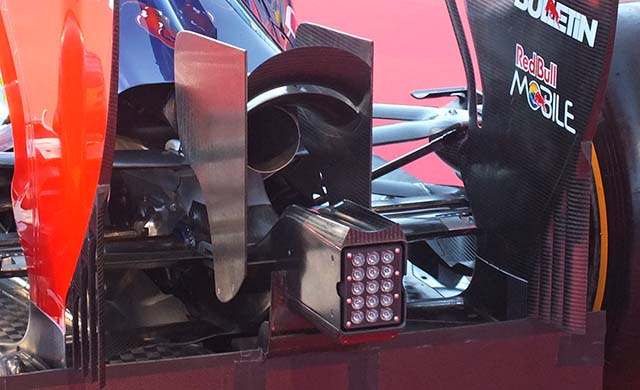
The rear of the bespoke aluminium casing of the Toro Rosso transmission is just visible in this shot along with a number of other very interesting details (a larger version of this image is available in the gallery at the top of this page). The rear wing on the STR9 is endplate mounted, this means that the DRS actuation is via one (or both) of the endplates. Not having a central pillar could free up airflow to the under side of the rear wing. Also of interest is the design of the ‘monkey seat’ mini rear wing, the biggest seen to date on any F1 car. The endplates are substantial. Notably the underside of the curved wing elements are clearly influenced by the exhaust gasses (the location of the exit is obvious). There is also a sculpting on the upper surface of the rear crash structure. Interestingly none of these areas have any noticeable thermal barrier treatment meaning either the exhaust gas is not that hot, the thermal barrier is not evident on the launch spec car or that some carbon fibre is going to get toasted.
Also note the upper rear wishbone mounting point on a raised section on the gearbox casing.

Whilst the diffuser was covered at the launch one interesting detail was not, a lower wing element just above the diffuser. This may replace some of the loss of the lower beam wing’s removal as part of the 2014 rule changes.
Chief Designer Luca Furbatto continues: “We started STR9 in the summer of 2012, initially just purely on the simulation side. When James Key arrived in late 2012, he focused mainly on the 2014 car in terms of planning, simulation targets and internal resourcing whilst we were still designing the STR8. To his credit we were able to perform the first STR9 wind tunnel test shortly before Christmas 2012, much earlier than previous Toro Rosso projects.”
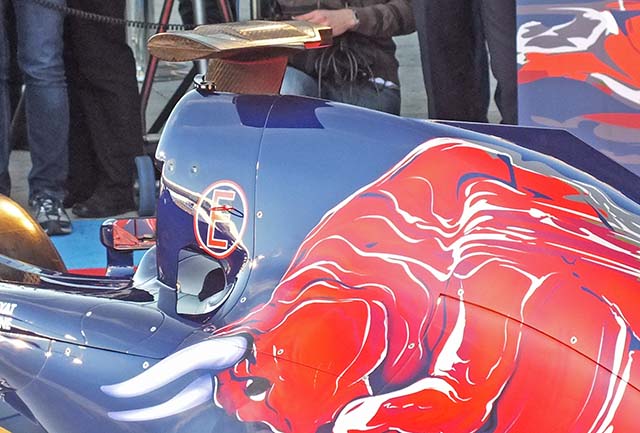 The roll hoop is a fascinating design, in ducting terms it is a triple decker layout, with the traditional roll hoop aperture used for the engine intake (primarily for combustion), whilst the large central duct serves a cooling role, a third much small duct visible in the image above also serves a cooling purpose.
The roll hoop is a fascinating design, in ducting terms it is a triple decker layout, with the traditional roll hoop aperture used for the engine intake (primarily for combustion), whilst the large central duct serves a cooling role, a third much small duct visible in the image above also serves a cooling purpose. 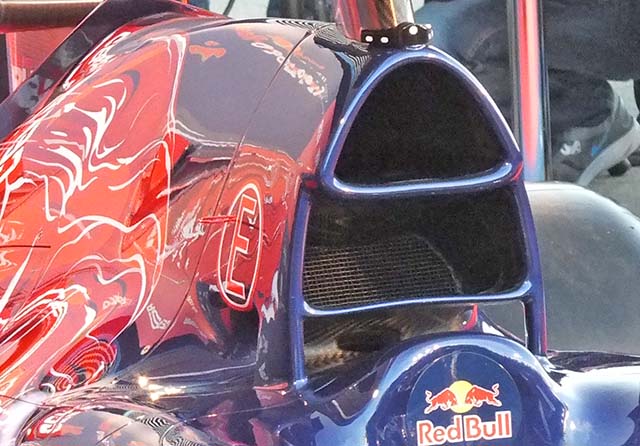 The cooling ducting on the STR9 (above) is a more extreme version of the layout used on the 2012 STR7 (below). Note that the supports of the roll hoop are curved, unusual for a structural part.
The cooling ducting on the STR9 (above) is a more extreme version of the layout used on the 2012 STR7 (below). Note that the supports of the roll hoop are curved, unusual for a structural part.
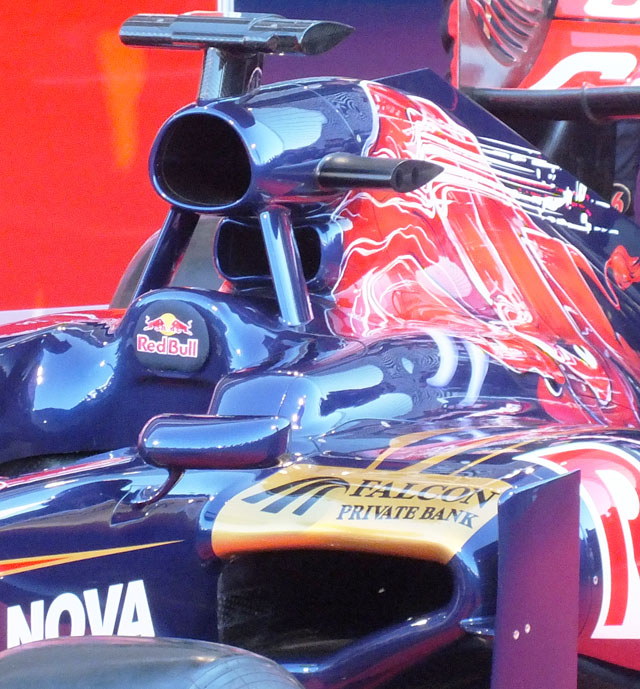
“The cooling side has been a massive challenge for us as we have also had to deal with the added factor of changing our engine supplier. In 2014 the hybrid proportion is much more significant and therefore it generates more heat, that needs to be cooled too. Furthermore, using a turbocharger means the engine requires intercoolers, which we haven’t had on F1 cars since the mid-80s. Certainly, the radiator layout plays an important role in the overall car layout and we had a few moving targets during the design phase, which means we ended up sizing 17 different layouts for cooling on STR9 and eventually committing to just one!
In doing so we relied on the work of several departments within Scuderia Toro Rosso and we have invested heavily in doing dyno testing and core measurements to ensure that we are as optimised as possible in terms of cooling. I am sure that activities related to cooling refinements will continue over the course of this season”
““Clearly, we are packaging things in a way that will allow us some development flexibility also from the aerodynamic side because ultimately, we need to find a performance sweet spot between aero, PU performance, fuel consumption and cooling capability” continues Furbatto. “With this latest regulation there a finer balance between downforce and drag due to the fuel consumption effect which has not been such a big factor until this season.”
Apart from engine and aero changes, the new rules also allow for an interesting new braking technology. “Braking By Wire, or BBW is another new system that we will race in 2014,” continues Furbatto. “In order to open up energy harvesting strategies during the braking phase the FIA will allow a semi active electronic control of the rear braking pressure line. The BBW will allow the braking load to fluctuate from pure engine braking to pure friction braking or any combination in between without the driver noticing it on the brake pedal! The exact amount of brake pressure on the rear line will be mapped against engine braking that will then be used to recharge the on-board batteries” Furbatto continues.
Another change in the rules is that the minimum weight of the car has gone up by 50 kg. That sounds a lot, but much of it is simply absorbed by the fact the new power unit weighs more than the V8 it replaces. “In addition, there are enhanced safety structures for side impact and the chassis has been made significantly stronger than last year so the weight of the survival cell will go up in this area too,” adds Furbato. We will only be able to carry a very limited amount of ballast or no ballast at all, depending of the driver’s weight. The possibility of running without ballast could be a limitation, both in terms of weight distribution, tune ability or simply tipping over the edge of being overweight. We started an aggressive weight saving programme on STR8 in order to get prepared for 2014. The only thing we kept of STR8 is the pedal set, although even here we managed to reduce the weight of it last summer” Furbatto reveals.

The nose shape of the Toro Rosso has drawn many comments including one amusing one from the Ann Summers sex shop chain in the UK. Its not one that takes too much imagination. The shape of the nose is clearly all about channelling airflow under the nose in a particular way, note the sculpting either side of the “Ann Summers part”. The central section of the front wing is common to all cars and defined by the technical regulations. Note the neat driver cooling duct in the tip of the nose.
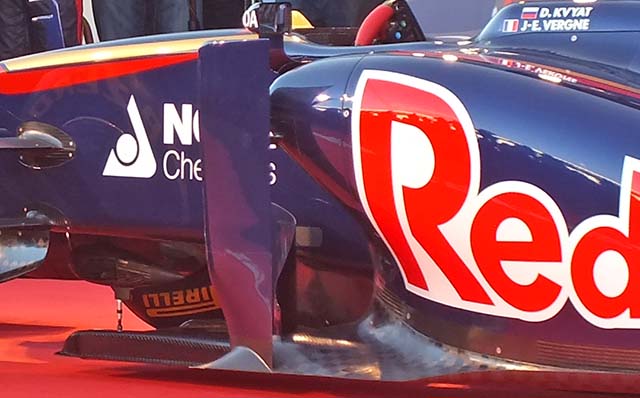
A nice look at the sidepod undercut and the front floor. Note how small the stay is despite much tougher regulations in this area. In 2014 the rules mandate that the floor here must be twice as stiff as in 2013. The turning vane is a carry over from the 2013 concept and a key area for further development
TEST 01: JEREZ SPAIN
A look at the rear floor reveals the now common cut out ahead of the rear wheel as well as Sauber style strakes. The cooling exit slits are also evident.
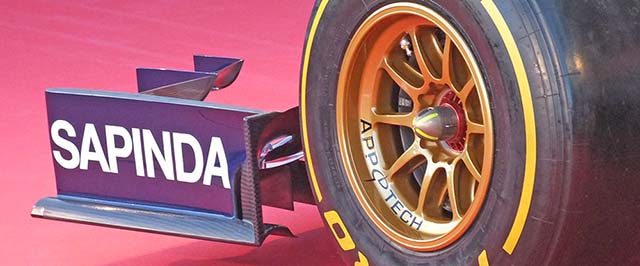
The front wing design will be crucial in 2014, with the endplates and wing shape not leaving a clear direction for the teams to pursue either inwash or outwash.
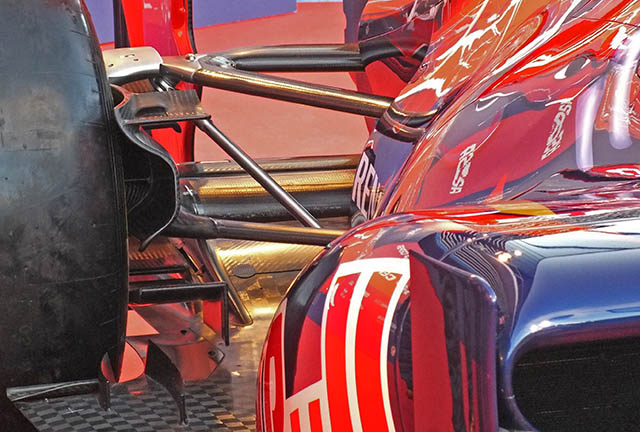
The STR9 retains a pull rod rear suspension layout, but here we can see a number of interesting aerodynamic details, the floor strakes have been mentioned but here you can see that they are being used to channel air flow to the inner edge of the rear wheel. This helps seal off the diffuser from the turbulent air from the base of the rotating tyre. Also note the shape of the brake duct turning vanes. The driveshaft appears to be shrouded.
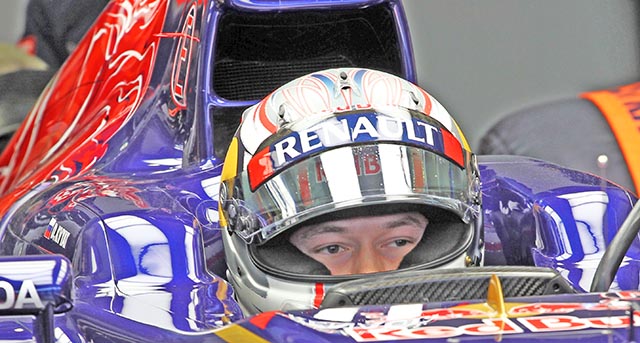
The cooling duct on the Toro Rosso appears to be partly blocked by the drivers helmet but it is likely to have been taken into account by the designers.
TEST 02: SAKHIR, BAHRAIN
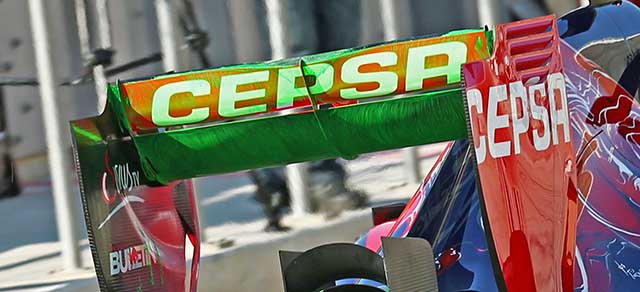
The Red Bull junior team conducted some rear wing comparison work in Bahrain. Initially flow vis runs were conducted (above).
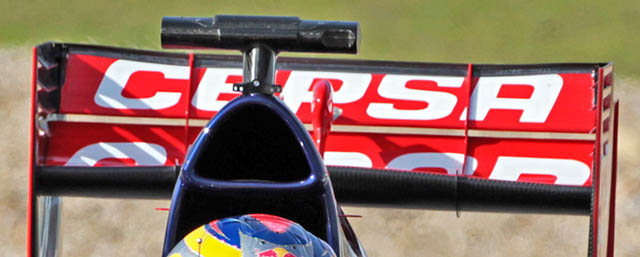
But then whole new rear wing design was fitted. Compare the launch specification (above) with the new wing (below). The launch version seems more complex than the newer version
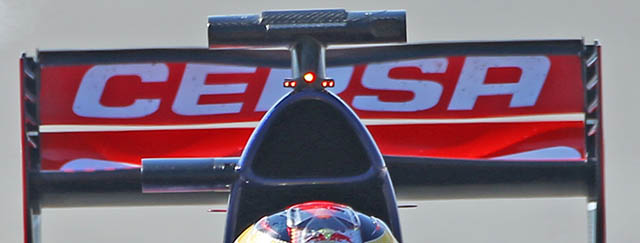
Alongside the new wing Toro Rosso brought some new rear bodywork, closing up the vent ahead of the rear suspension, the forward element of the upper rear wishbone now passes through the rear of the side pod. Note the single strake in place of the two which appeared at Jerez(below)
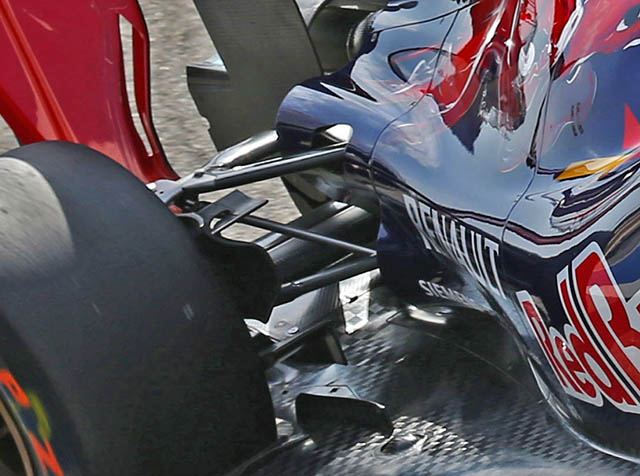
These changes are likely due to the unexpectedly high cooling demands of the Renault RS34. Compare with the old layout (below)
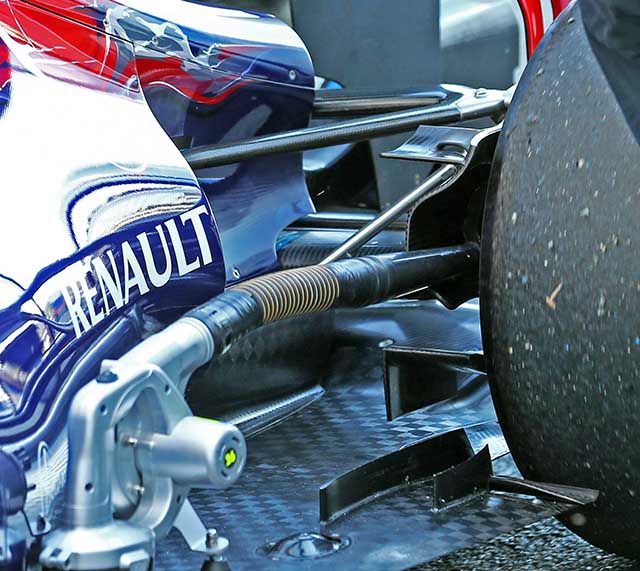
TEST 03: SAKHIR, BAHRAIN
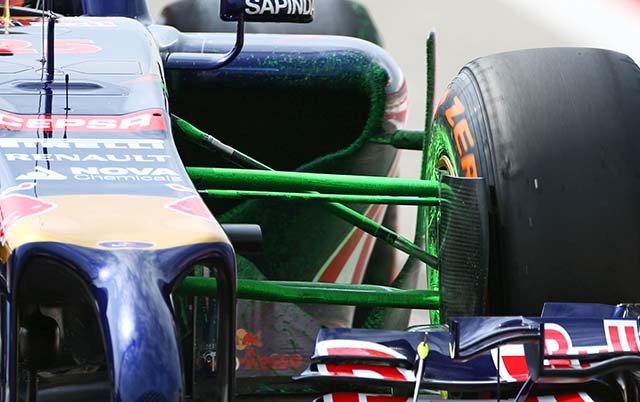
Toro Rosso spent some time evaluating the airflow around the brake ducts and front suspension at the final test (above) using flow vis dye, a similar process was conducted at the rear (below).
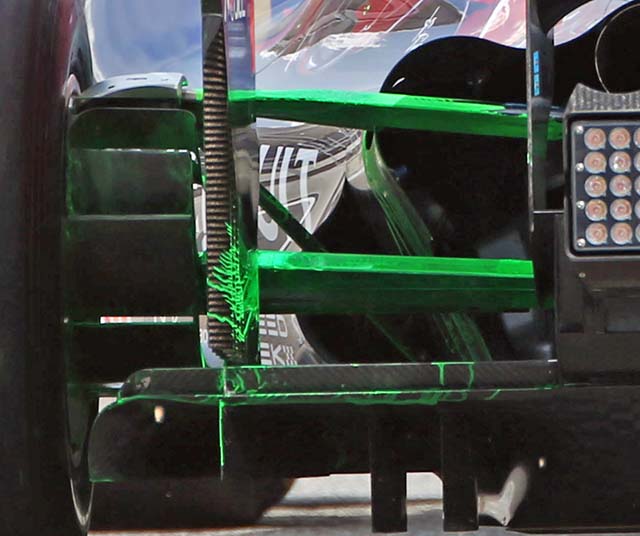
A new nose was then fitted to the STR9, and further aerodynamic evaluation, this new nose appears to retain at least some elements of the launch spec nose so may not have required a new crash test.
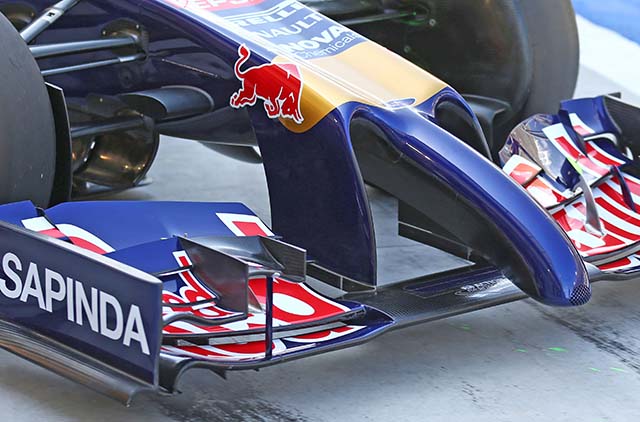
The new part (above) sees the wide section of the nose start further back and the central section is highly sculpted, dipping in the centre, whilst the old spec had a much flatter upper surface. The car also features a new front wing, the forward upper section of the wing now features three elements at the outer ends whilst the launch spec version (below) only had two.
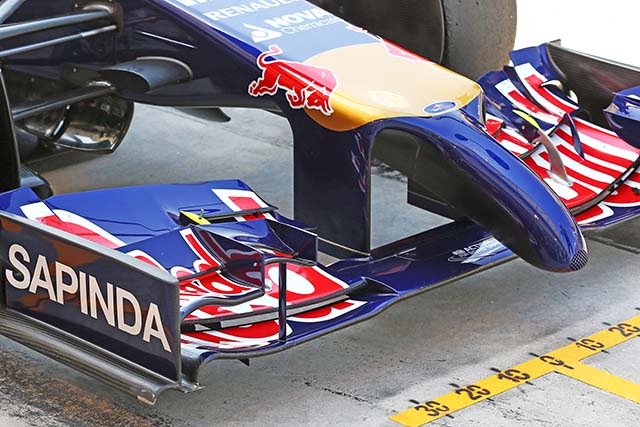
Once the wing and nose were fitted the configuration was tested using an air speed sensor array (below)
